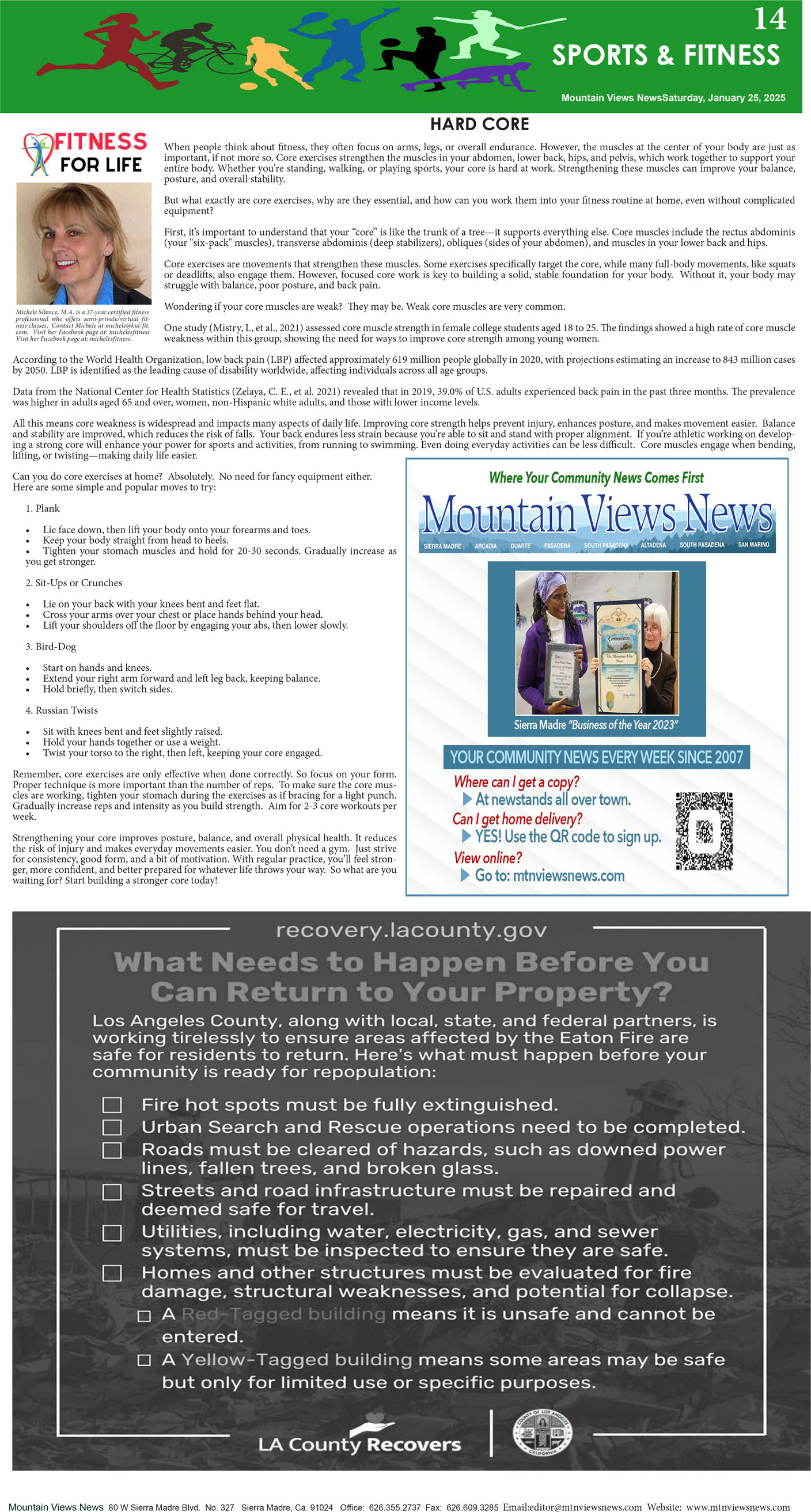| 
14
SPORTS & FITNESS
Mountain Views NewsSaturday, January 25, 2025
HARD CORE
When people think about fitness, they often focus on arms, legs, or overall endurance. However, the muscles at the center of your body are just as
important, if not more so. Core exercises strengthen the muscles in your abdomen, lower back, hips, and pelvis, which work together to support your
entire body. Whether you're standing, walking, or playing sports, your core is hard at work. Strengthening these muscles can improve your balance,
posture, and overall stability.
But what exactly are core exercises, why are they essential, and how can you work them into your fitness routine at home, even without complicated
equipment?
First, it’s important to understand that your “core” is like the trunk of a tree—it supports everything else. Core muscles include the rectus abdominis
(your "six-pack" muscles), transverse abdominis (deep stabilizers), obliques (sides of your abdomen), and muscles in your lower back and hips.
Core exercises are movements that strengthen these muscles. Some exercises specifically target the core, while many full-body movements, like squats
or deadlifts, also engage them. However, focused core work is key to building a solid, stable foundation for your body. Without it, your body may
struggle with balance, poor posture, and back pain.
Wondering if your core muscles are weak? They may be. Weak core muscles are very common.
One study (Mistry, I., et al., 2021) assessed core muscle strength in female college students aged 18 to 25. The findings showed a high rate of core muscle
weakness within this group, showing the need for ways to improve core strength among young women.
According to the World Health Organization, low back pain (LBP) affected approximately 619 million people globally in 2020, with projections estimating an increase to 843 million cases
by 2050. LBP is identified as the leading cause of disability worldwide, affecting individuals across all age groups.
Data from the National Center for Health Statistics (Zelaya, C. E., et al. 2021) revealed that in 2019, 39.0% of U.S. adults experienced back pain in the past three months. The prevalence
was higher in adults aged 65 and over, women, non-Hispanic white adults, and those with lower income levels.
All this means core weakness is widespread and impacts many aspects of daily life. Improving core strength helps prevent injury, enhances posture, and makes movement easier. Balance
and stability are improved, which reduces the risk of falls. Your back endures less strain because you’re able to sit and stand with proper alignment. If you’re athletic working on developing
a strong core will enhance your power for sports and activities, from running to swimming. Even doing everyday activities can be less difficult. Core muscles engage when bending,
lifting, or twisting—making daily life easier.
Can you do core exercises at home? Absolutely. No need for fancy equipment either.
Here are some simple and popular moves to try:
1. Plank
• Lie face down, then lift your body onto your forearms and toes.
• Keep your body straight from head to heels.
• Tighten your stomach muscles and hold for 20-30 seconds. Gradually increase as
you get stronger.
2. Sit-Ups or Crunches
• Lie on your back with your knees bent and feet flat.
• Cross your arms over your chest or place hands behind your head.
• Lift your shoulders off the floor by engaging your abs, then lower slowly.
3. Bird-Dog
• Start on hands and knees.
• Extend your right arm forward and left leg back, keeping balance.
• Hold briefly, then switch sides.
4. Russian Twists
• Sit with knees bent and feet slightly raised.
• Hold your hands together or use a weight.
• Twist your torso to the right, then left, keeping your core engaged.
Remember, core exercises are only effective when done correctly. So focus on your form.
Proper technique is more important than the number of reps. To make sure the core muscles
are working, tighten your stomach during the exercises as if bracing for a light punch.
Gradually increase reps and intensity as you build strength. Aim for 2-3 core workouts per
week.
Strengthening your core improves posture, balance, and overall physical health. It reduces
the risk of injury and makes everyday movements easier. You don’t need a gym. Just strive
for consistency, good form, and a bit of motivation. With regular practice, you’ll feel stronger,
more confident, and better prepared for whatever life throws your way. So what are you
waiting for? Start building a stronger core today!
Michele Silence, M.A. is a 37-year certified fitness
professional who offers semi-private/virtual fitness
classes. Contact Michele at michele@kid-fit.
com. Visit her Facebook page at: michelesfitness
Visit her Facebook page at: michelesfitness.
Mountain Views News 80 W Sierra Madre Blvd. No. 327 Sierra Madre, Ca. 91024 Office: 626.355.2737 Fax: 626.609.3285 Email:editor@mtnviewsnews.com Website: www.mtnviewsnews.com
|